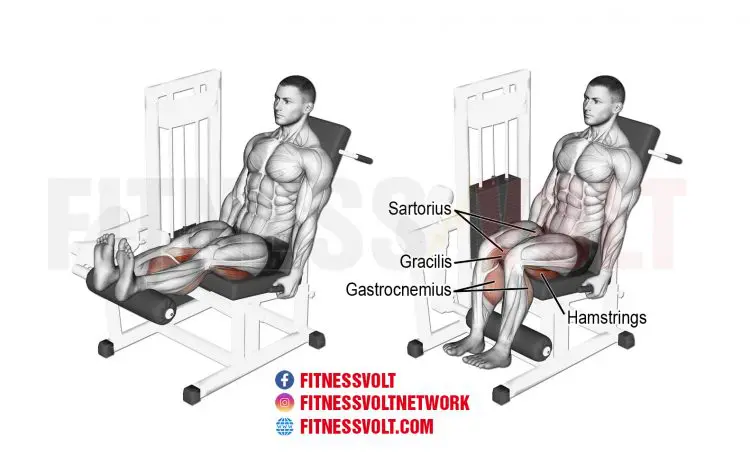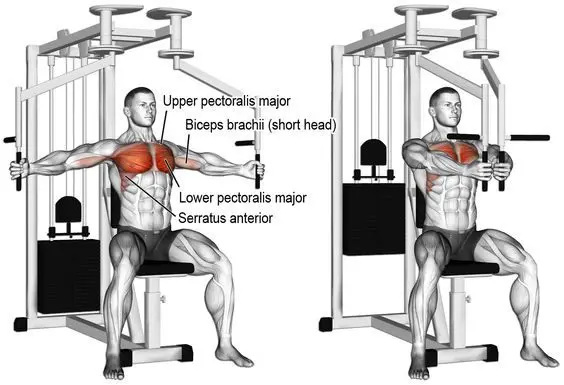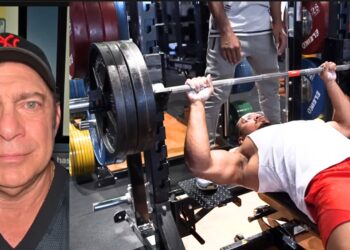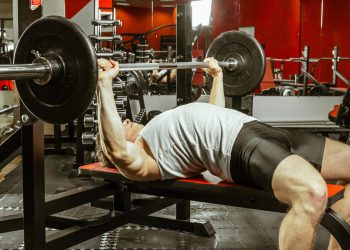There is absolutely nothing wrong with following a pre-designed strength, fat loss, and bodybuilding program. However, you may get better results if you create your own workouts. Planning your own training means you can customize your approach based on your needs, goals, abilities, and preferences. Even small tweaks can make your workout more productive.
Of course, to write your own program, you need to have a firm grasp on things like sets, reps, loading, volume, rest periods, training splits, and, exercise selection. After all, these are the components that make up your workouts.
On the exercise front, you have a lot to choose from, and some are definitely better than others. While there is no such thing as a bad exercise, there are exercises that work better than others or are more appropriate for your goals.
You also need to pick between training modalities, i.e., free-weights, machines, resistance band, or bodyweight exercises.
However, the main exercise decision you’ll need to make is between single and multi-joint exercises. Get this choice right, and your program is much more likely to deliver the results you want.
In this article, we reveal the difference between single and multi-joint exercises and explain which one you should use.
Level Up Your Fitness: Join our 💪 strong community in Fitness Volt Newsletter. Get daily inspiration, expert-backed workouts, nutrition tips, the latest in strength sports, and the support you need to reach your goals. Subscribe for free!
What Are Single-Joint Exercises?
Single-joint exercises are also known as isolation exercises. This is a little confusing because no muscle actually works in isolation. Almost every human movement is the result of several muscles working together. That’s why the term single-joint exercise is probably more accurate and useful than isolation exercise.
Anyway, naming arguments aside, single-joint exercises involve movement at just one joint. Single joint exercises allow you to emphasize specific muscle groups. Examples of single-joint exercises, showing the joint and main muscle involved, include:
- Leg extension (knee joint/quadriceps)
- Leg curl (knee joint/hamstrings)
- Calf raise (ankle joint/triceps surae)
- Biceps curl (elbow joint/biceps)
- Triceps extensions (elbow joint/triceps)
- Pec deck (shoulder joint/pectoralis major)
- Crunches (spine/rectus abdominus)
Pros and Cons of Single-Joint Exercises
Not sure if you should include single-joint exercises in your workouts? Consider these pros and cons!
Pros:
Good for localized hypertrophy – if you want to build a specific muscle, single-joint exercises can help. For example, biceps curls are arguably the best way to increase biceps size. Your biceps ARE involved in things like pull-ups and bent-over rows, but they work as synergists rather than agonists. If you want to directly target a particular muscle, single joints allow you to do so.
Useful for fixing muscle imbalances – while multi-joint exercises like squats, lunges, deadlifts, and leg presses work all your major leg muscles, some end up working harder than others. Isolation exercises allow you to fix these imbalances. For example, combining leg presses with leg curls will ensure your quads and hamstrings are developed equally.
Easy to learn – most single-joint exercises require minimal coordination. After all, you only need to move one joint at a time. This means they’re often easier to learn than multi-joint exercises for the same muscle groups. For example, the pec deck is easier to learn and master than bench presses or push-ups.
A little weight goes a long way – because they involve fewer muscles, you probably won’t need to use as much weight for single-joint exercises as you do multi-joint exercises. For example, you won’t be able to dumbbell fly as much weight as you can dumbbell bench press. This may be useful if you are a home exerciser who only has light dumbbells to train with.
Cons:
Not so good for strength – while you can strengthen your muscles with isolation exercises, your inability to lift heavy weights means you probably won’t get as strong compared to doing more multi-joint lifts. For example, you’ll achieve higher levels of strength by doing squats rather than leg extensions.
Not as functional as most multi-joint exercises – most strenuous movements involve multiple joints and muscles working together. Lifting, kicking, pushing, and pulling are all examples of multi-joint movements.
Single-joint exercises are generally less functional than most multi-joint exercises because they don’t tend to mirror the movements of daily life.
For example, it’s very rare to extend or flex your knees alone (e.g., leg extensions/leg curls). Usually, your knees work with your hips and ankles (e.g., squats/lunges).
Not as time-efficient – you can train your entire body with just 3-5 multi-joint exercises. You’d need to use a lot more exercises to train all your muscles if you relied solely on single-joint exercises. If you want a more time-efficient workout, single-joint exercises are not your best choice.
What Are Multi-Joint Exercises?
Multi-joint exercises are also known as compound exercises. They involve movement at two or more joints and work several muscles together. During multi-joint exercises, the muscles involved are readily identified and given specific names based on their roles:
Agonist or Prime Mover: This is the main muscle doing most of the work. It’s usually the muscle you want to train.
Antagonist: This muscle opposes the agonist. It relaxes to allow smooth joint movement. It’s generally found on the opposite side of the same joint as the agonist, e.g., the hamstrings during leg extensions.
Synergist: Synergists are helper muscles. They assist the agonist in performing the desired movement. Usually smaller than the agonist, the synergist is often located at a nearby joint.
Stabilizer: Stabilizers prevent unwanted movement. They often work isometrically or statically to hold a joint in place. The core muscles and rotator cuff muscles often work as stabilizers.
While the muscles involved in a single-joint exercise can also be identified as agonists, antagonists, stabilizers, etc., any synergists are usually less obvious.
Examples of compound exercises, showing the joints and main muscles involved, include:
- Squats (knee and hip joints/quadriceps, hamstrings, gluteus maximus)
- Bench presses (shoulder and elbow joints/pectoralis major, deltoids, triceps)
- Bent-over rows (shoulder and elbow joints/latissimus dorsi/biceps)
- Lunges (knee and hip joints/quadriceps, hamstrings, gluteus maximus)
- Push-ups (shoulder and elbow joints/pectoralis major, deltoids, triceps)
- Pull-ups (shoulder and elbow joints/latissimus dorsi/biceps)
Pros and Cons of Multi-Joint Exercises
Are multi-joint exercises the right type of movement for you? Consider this list of pros and cons and then decide!
Pros:
They mirror the demands of everyday life – a lot of multi-joint exercises replicate the movements of daily living. As such, strength developed through multi-joint exercises should carry over well to life outside the gym. For example, squats train your legs as they work in nature, i.e., with all the leg muscles and joints working together.
Better for building maximal strength – powerlifters and strongmen mainly use multi-joint exercises for a reason; they’re best for building brute strength. If you want to lift a heavy weight, you don’t use just one or two muscles. Instead, you use multiple muscle groups so you can generate maximal force. Also, multi-joint exercises allow you to train with heavier weights than single-joint exercises, leading to more significant strength gains.
Level Up Your Fitness: Join our 💪 strong community in Fitness Volt Newsletter. Get daily inspiration, expert-backed workouts, nutrition tips, the latest in strength sports, and the support you need to reach your goals. Subscribe for free!
Higher energy cost – if you want to lose weight or burn fat, multi-joint exercises are better than single-joint exercises. Using multiple muscles simultaneously will burn more calories, which should enhance your weight loss efforts.
Develop better balance and intermuscular coordination – lifting weights doesn’t just affect your muscles; it affects your nervous system, too. Doing multi-joint exercises will benefit neurological functions like balance and coordination more than single-joint exercises. After all, which requires (and therefore develops) more balance and coordination; leg extensions or lunges?
Cons:
Generalized rather than localized hypertrophy – exercises like squats, bench presses, and pull-ups are great muscle-building exercises. Still, they involve several muscle groups working together. For example, during bench presses, your triceps and deltoids also get a workout along with your pecs.
You may find that the muscles you want to train get “lost” among all the other muscles being worked. You may even feel your synergists more than your agonists, i.e., your biceps more than your lats during pull-ups.
Heavier weights – lifting heavier weights can be a double-edged sword. On the one hand, it means that multi-joint exercises are generally better for building strength. But, on the other hand, there will be more joint stress, and you may be tempted to try and lift more weight than is safe.
Can create muscle and movement imbalances – some exercisers are against using single-joint exercises. However, relying solely on multi-joint exercises could mean that some muscles end up being under-trained.
For example, the only effective way to train the knee flexion function of the hamstrings is with leg curls. Multi-joint exercises like deadlifts also work the hamstrings, but only the hip extension function. It would also be very hard to develop your calves, medial deltoids, abs, biceps, and triceps without a few well-chosen single-joint exercises.
Single Vs. Multi-Joint Exercises:
So, now that you know a little more about single and multi-joint exercises, let’s judge these two types of movement by a few different criteria:
Strength
When it comes to building strength, exercise specificity matters. This means, if you want to get stronger at leg extensions, you need to include heavy leg extensions in your workouts. Conversely, if you want to deadlift more weight, you need to build your workouts around deadlifts.
That said, it really doesn’t make a lot of sense to strengthen a single muscle group, as that’s not how your body works in nature. So, while you can build strength with single-joint exercises, multi-joint exercises are generally the best choice.
The only exceptions to this “rule” are if you need to specifically strengthen a muscle to reduce the risk of injury or address a muscle imbalance. In these instances, single-joint exercises would be used as accessory exercises.
Hypertrophy
You can build muscle mass with single and multi-joint exercises. However, single-joint exercises allow you to target specific muscle groups with greater precision. That said, you’d need to use a long list of single-joint exercises to develop all your muscles equally.
That’s why most bodybuilding programs use a combination of multi AND single-joint exercises. You’ll get better results from your muscle-building workouts if you combine both types of exercise.
Power
Power is your ability to generate force quickly. Activities that demonstrate power include jumping, throwing, kicking, and punching. Most power activities involve multiple joints and muscles working together. Many are deemed full-body activities.
Training should replicate the demands of the activity you want to get better at. As such, the best power exercises are also compound in nature. It would be impractical if not impossible to develop power with single-joint exercises.
Fat burning
Multi-joint exercises have a higher metabolic cost than single-joint exercises (1). As such, if your goal is to burn fat or lose weight, your workout should contain more multi-joint than single-joint exercises.
A set of squats requires more energy than a set of leg extensions done to the same level of fatigue. Your heart and breathing rate will also be higher, which is a good indicator that you are working harder.
Functionality
Very few single-joint exercises mirror the movements performed during activities of daily life or sports. In contrast, a lot of multi-joint exercises use movements that are recognizable outside of the gym.
If you want to develop functional strength and fitness, meaning you want to perform better out in the real world and away from the gym, multi-joint exercises should be your primary mode of training.
Safety
Because multi-joint exercises tend to allow lifters to use heavier weights and require more balance and coordination, they could be somewhat riskier than single-joint exercises. That said, some single-joint exercises put more shearing force on the joints, which could be a source of injury.
However, done correctly, all types of exercise can be safe. Similarly, done incorrectly or with too much weight, any exercise can be dangerous, too. As such, it’s the user that usually determines how safe an exercise is.
Ease of learning
Ease of learning is largely subjective. Some people will have no problem picking up even complex multi-joint exercises. In contrast, others may never grasp how to do something like squats or deadlifts correctly.
However, because the movements tend to be simpler, most lifters should find single-joint exercises easier to master than multi-joint exercises. Single-joint exercises usually require less balance and coordination.
Wrapping Up
On paper, at least, it looks like multi-joint exercises have got single-joint exercises well and truly beat! They’re better for strength, more functional, more effective for fat loss, more useful for power training, and just as good for hypertrophy.
But, in reality, adding single-joint exercises to your multi-joint workout will probably enhance your training, producing even better results (2).
A lot of people are quick to dismiss single-joint exercises because of their lack of real-world functionality, but they’re unbeatable for targeting specific muscle groups. Done alongside multi-joint exercises, single-joint movements allow you to plug the developmental gaps that can arise if you only ever do multi-joint lifts.
So, don’t discriminate between single and multi-joint exercises – make use of both of these types of training. That way, you can enjoy all the benefits on offer.
References:
1 – PubMed: Energy Cost of Isolated Resistance Exercises Across Low to High-Intensities https://www.ncbi.nlm.nih.gov/pmc/articles/PMC5524349/
2 – PubMed: Varying the Order of Combinations of Single and Multi-Joint Exercises Differentially Affects Resistance Training Adaptation https://pubmed.ncbi.nlm.nih.gov/32149887/

